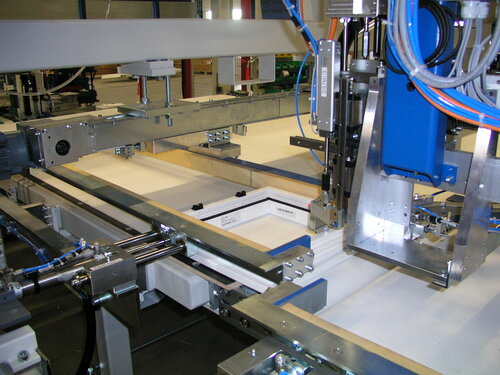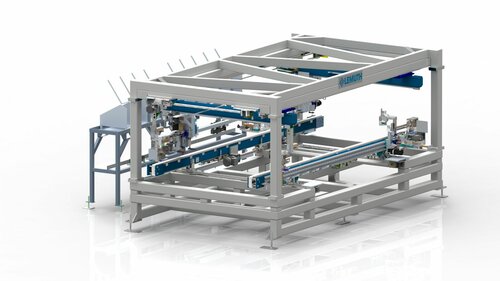Automatic bolting of clamped fittings
Automatic bolting of the clamped fittings on the sash - FBS 131.K
Besides the already known Lemuth solutions for fully automatic sash fittings assembly, an appliance for semi-automatic sash fittings assembly has now been designed. Based on clampable fittings systems, this appliance bolts all preassembled fittings to the sash units. Sash hinges may also optionally be predrilled, set and bolted. The appliance, consisting of a preceding sash fitting clamping station FBK135 and an automatic bolting machine FBS131, is the optimal entry device for automated fittings assembly.
Completely independent of fittings and profiles
The transport and clamping devices of the automatic machines have been designed in a way that is independent of profiles. All screwdrivers can be positioned at different groove position heights. Thus the fittings and profile systems are easy to change. In addition to the independence of fittings, it is also possible to use different screw lengths on one automatic machine. The sash units to be machined can be made of PVC, aluminium or painted wood.
Easy operation and optimum service
The large TFT display shows the respective tasks to be performed by the operator. The industrial PC, which comes with a Beckhoff control, is controlled via a highly intuitive LEMUTH user interface that has been specially designed for this application. Of course this system offers possibilities for remote maintenance to avoid as far as possible onsite service assignments and to help solve problems fast.
Choosing the right configuration
Various configurations enable every window manufacturer to find an automatic machine that best suits their needs.
The material to be machined is decisive for the layout of the machining station. Especially for wooden units, the machining table is equipped with belt drives that ensure the gentle and damage-free transport of the window units. Every automatic machine can be optionally used as a single-station variant or as a pass-through variant. The variants differ in the transport of the finished parts. Whereas with the single-station variant the finished sashes are transported back to the preceding sash fittings clamping station FBK135, the automatic fittings bolting machine transfers the sashes to the following unit such as the stacker equipment AS165 when the pass-through variant is used.
Possible extensions
All LEMUTH machines can be used as STAND-ALONE equipment or can be easily integrated into an existing production line. So it is possible that the automatic stacker equipment of series AS165 will be joined after an automatic bolting machine. LEMUTH stackers are available in various configurations and designs.
By adding further magazines and handling units the machine can be upgraded to the series FBA136 automatic machine for the fully automatic fittings assembly, which permits the fully automatic mounting of corner guides, sash hinges and interlocking rods in one system.
When machining wooden units, an automatic clip setting unit can be integrated for the automatic mounting of the clips used for attaching the aluminium shells.
Automatic bolting of the clamped fittings on the sash, simultaneously to all 4 frame legs in 1 minute
All fittings are clamped by the operator on the preceding sash fittings clamping station FBK135 into the fittings groove of the sash. After the operator has released the unit for machining, the sash will be gently transported by belt drives to the machining position. Wooden units as well as sashes made of PVC are clamped along the entire length of the frame leg against the locating edge. This novel clamping method prevents pressure marks on the sensitive wood sashes. For the machining of large units, additional counterpressure cylinders are provided for the bolting process to prevent any deformation of the frame legs. Then the four servo-controlled high-duty screwdrivers, which can be freely positioned, bolt all fittings simultaneously to all four frame legs. The servo-controlled motors provided at every screwdriver block permit the adjustment of the optimum torque depending on the type of wood and the type of screws used. Overtightened or projecting screws will thus be avoided.
Latest modification: 07.02.2022



